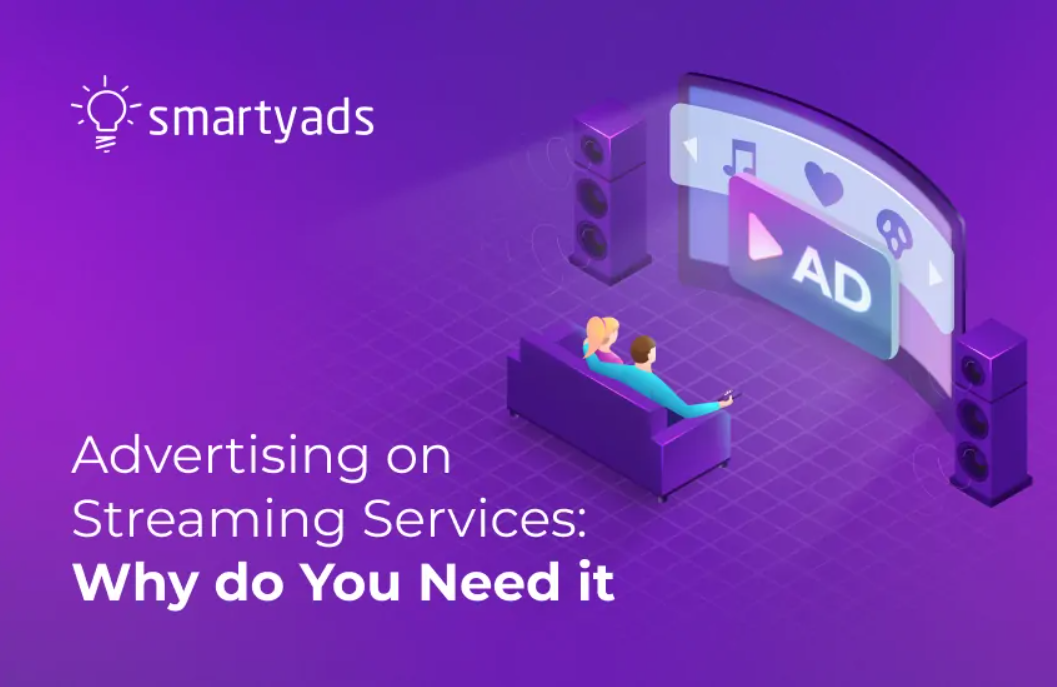Advertising on streaming services is a popular way for businesses to reach a large and engaged audience. Streaming services like Netflix, Hulu, and Amazon Prime Video offer a unique opportunity for businesses to reach viewers who are actively engaged with the content and more likely to pay attention to ads. Let's review streaming advertising more precisely.

What is Streaming TV Advertising?
There are several ways how businesses can advertise on streaming platforms. One popular method is through "in-stream" ads, which are short ads that appear before, during, or after a streaming video. These ads can target specific audiences based on location, age, gender, and interests.
Another option for businesses is to sponsor or create their own content on streaming services.
For example, a business might create a branded series distributed on a streaming service like Netflix. This approach can be more expensive than in-stream ads, but it allows businesses to create highly relevant content for their target audience.
The Streaming TV Video Service Marketplace
The streaming TV video service marketplace is a highly competitive and rapidly evolving space, with new players entering the market and existing players constantly expanding their offerings. Some of the key streaming services:
Netflix. The world's largest streaming video service provider offers a wide range of original and licensed content across various genres and formats.
Amazon Prime Video. Amazon Prime Video is part of Amazon's Prime subscription service and offers a growing library of movies, TV shows, and original content.
Hulu. Hulu is a popular streaming service offering a mix of live TV and on-demand content from major networks and studios.
Disney+. Disney+ is a new player in the market, offering a broad range of content from Disney, Pixar, Marvel, Star Wars, and National Geographic.
HBO Max. HBO Max is a premium streaming TV service that offers exclusive content from HBO, as well as a growing library of movies and TV shows from various networks and studios.
Peacock. Peacock is NBCUniversal's streaming service, offering a mix of live TV and on-demand content, including exclusive original series and movies.
Apple TV+. Apple TV+ is Apple's streaming TV service, offering a range of original content across various genres and formats.
Youtube TV, Pluto TV, and Fire TV also belong to this niche.
In addition to these major players, there are smaller streaming TV services catering to niche audiences, such as Crunchyroll for anime fans or Shudder for horror enthusiasts.
Each of these platforms has its own ad guidelines. To advertise in CTV and OTT content, advertisers need to follow the ad guidelines of these popular platforms and stick to their rules for ad placement.
Streaming TV Ads Independent of Subscriptions
This was once the great promise of many streaming TV services: enjoying movies and shows without interruptions by ads. Or rather, interrupted only by the "Are you still watching?" insert, which, after watching several episodes in a row, kindly asked if we were still dozing off on the living room couch.
However, in 2023, Netflix and Disney+, the two largest ads streaming providers, plan to introduce ad-supported tiers. The ad-supported tier will allow advertisers to target audiences based on targeting criteria while users will watch ads and pay less for subscriptions.
Hulu, Amazon Prime Video, and YouTube TV already use this plan, thanks to which brands can target audiences precisely.
Users have learned about this from traditional TV or small German video-on-demand services, such as Joyn or RTL+.
Also, before the launch of Disney+ with streaming TV ads, a TiVo survey showed that 30% of Disney+ users said they would switch from their ad-free subscription to a cheaper tier as soon as it becomes available.
Disney+ plans to offer a subscription option with ads this December — first in the U.S. and then internationally. Netflix, meanwhile, plans to do so in early 2023.
Those who choose a subscription with streaming TV ads will pay less per month than the current offerings without streaming TV ads. But they will probably also have to do without some content and features.
For example, Netflix customers with an ad-supported subscription won't be able to download movies and TV shows to watch offline without an Internet connection. Technoblogger Steve Moser found a hint of this in the source code of the Netflix app.
However, for advertisers, this option of user interaction with content is more beneficial because then brands will have more opportunities to reach their audience with OTT or CTV streaming advertising.
What is OTT Advertising?
OTT (over-the-top) advertising refers to online video ads delivered through Internet-based streaming platforms like Netflix, Hulu, and Amazon Prime Video.
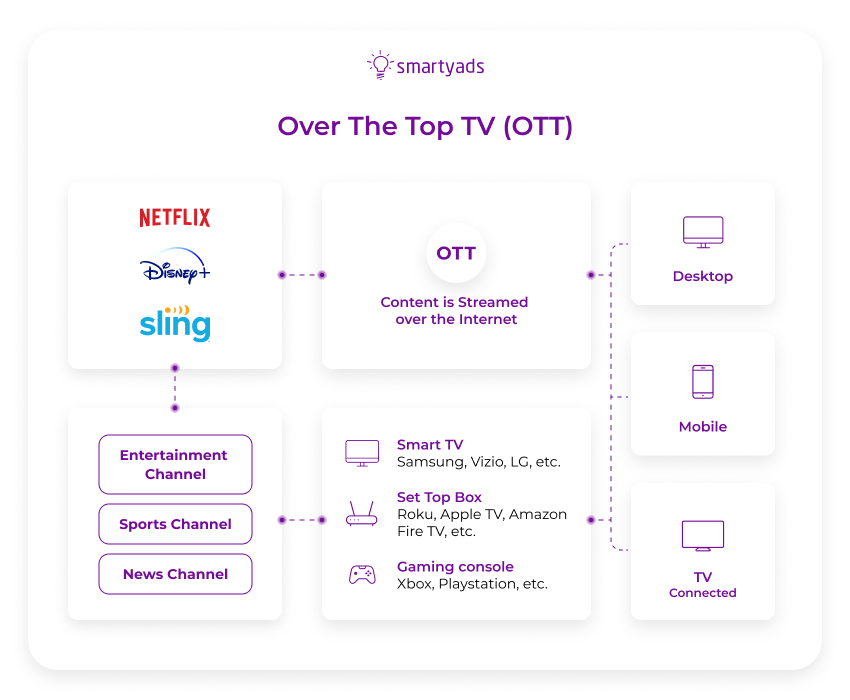
These services provide access to TV shows, movies, and other subscription video content that viewers can watch on their TVs, computers, or mobile devices, without traditional cable or satellite TV service.
OTT advertising is typically delivered as pre-, mid-, or post-roll ads, similar to the ads that viewers are accustomed to seeing on traditional TV. However, OTT ads offer several advantages over linear TV advertising, including:
1) Targeted advertising. OTT enables advertisers to deliver targeted ads based on viewer demographics, interests, and behaviors, which can result in higher engagement and conversion rates;
2) Measurable results. OTT provides advertisers with detailed analytics and metrics that can be used to measure digital video ad performance and optimize campaigns;
3) Cost-effective. OTT is often less expensive than linear television advertising, making it an attractive option for smaller businesses and startups that can buy advertising space more effectively;
4) Flexibility. OTT advertising allows advertisers to quickly and easily adjust video ad campaigns in response to changing market conditions or audience preferences.
OTT advertising is still a relatively new and evolving area; it presents unique challenges for advertisers, such as the need to navigate a fragmented marketplace and ensure that their TV ads are delivered in a brand-safe and effective manner.
However, the benefits of OTT advertising make it an increasingly important part of the overall advertising landscape.

What is CTV Advertising?
CTV (Connected TV) advertising refers to the practice of delivering online video ads through Internet-connected television devices such as smart TVs, streaming sticks, or gaming consoles.
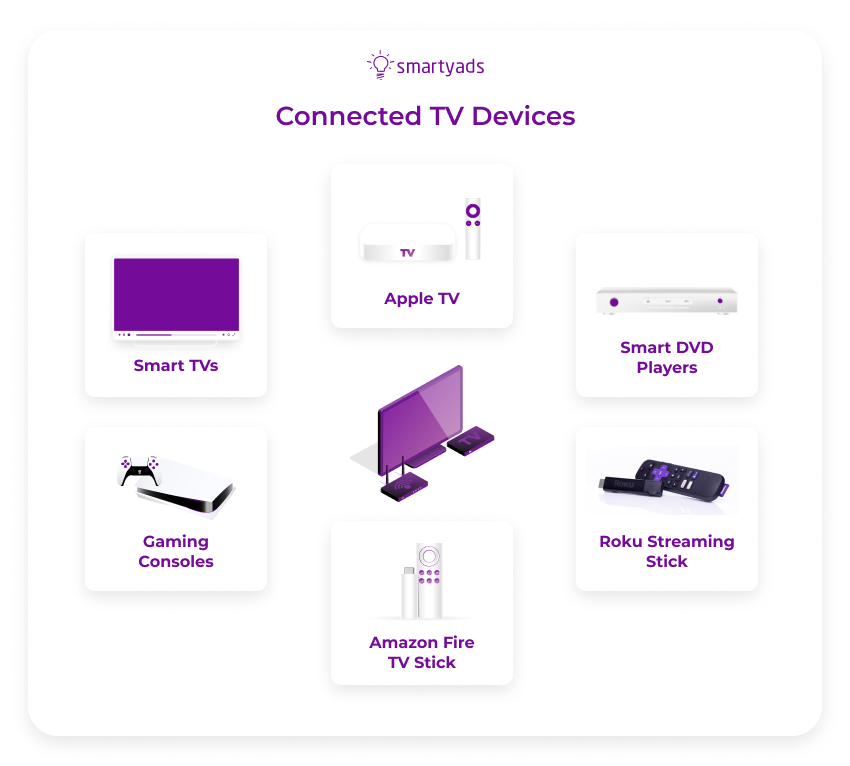
Unlike linear TV advertising, which relies on broadcast TV channels and cable networks, CTV reaches viewers through over-the-top (OTT) platforms that stream content over the Internet. This means that advertisers can target specific audiences based on demographics, interests, and behavior data, as well as track the performance of their ads in real time.
As a result, each user watches an individual ad on their TV screen while consuming the same content.
CTV ads have become increasingly popular as more consumers switch to Internet-connected devices and streaming services.
It provides advertisers a more targeted, measurable, and cost-effective way to reach audiences consuming TV content through streaming services rather than cable or satellite.
However, a frequent problem for advertisers is fraud, so you must be concerned about keeping your inventory safe from fraud.
OTT vs. Connected TV (CTV)
The difference between OTT and CTV may seem insignificant at first glance, but it is still there.
OTT (Over-The-Top) refers to the delivery of video content over the Internet, bypassing traditional cable or satellite TV providers. It includes streaming services like Netflix, Hulu, and Amazon Prime Video. OTT is generally delivered through a streaming device like Roku, Fire TV sticks, Apple TV, or smart TV.
On the other hand, connected TV (CTV) is a device connected to the Internet and allows users to access streaming content on their television. CTVs include smart TVs, gaming consoles, streaming devices, and Blu-ray players.
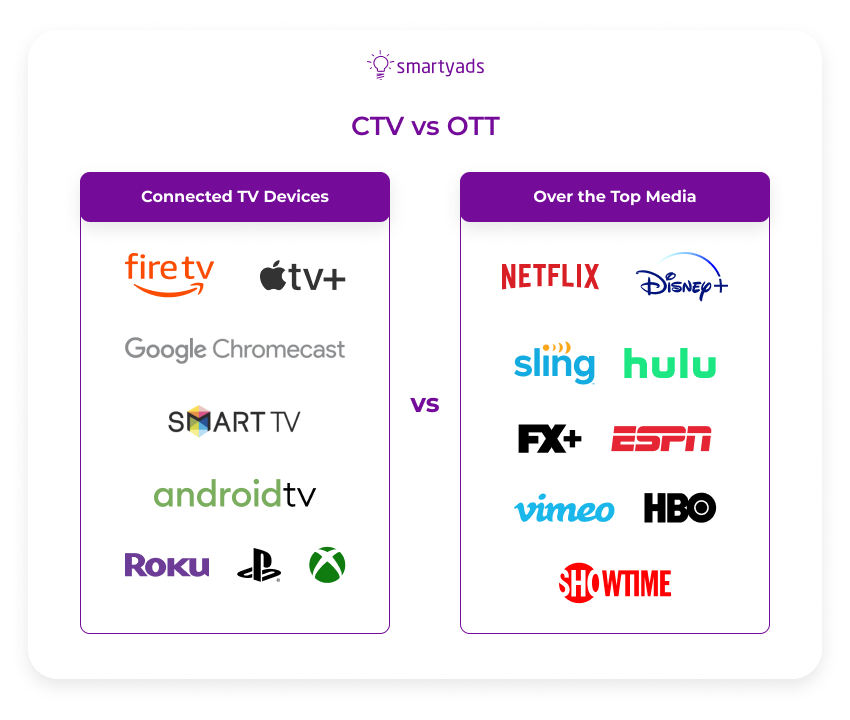
While there is some overlap between OTT and CTV, they are not the same thing. OTT refers to the delivery of video content, while CTV refers to the device used to access that content. OTT services can be accessed on CTVs, but they can also be accessed on mobile devices, tablets, and computers.
In summary, OTT is a method of delivering video content, while CTV is a device used to access that content on a television. OTT streaming grows while cable TV becomes less popular.
Best Practices for Streaming Advertising
Here are some steps you can follow to create effective online video ads for streaming TV:
Define your target audience
Identify your target audience and their interests, behaviors, and preferences. This will help you tailor your ad messaging and creative to resonate with them.
Choose the right ad format
Several ad formats are available for streaming TV and online video ads, such as pre-, mid-, and post-roll ads. Each format has its own strengths and limitations, so choose the one that fits your campaign goals and budget.
Develop a compelling message
Your ad should have a clear, concise message that grabs the viewer's attention and communicates your value proposition. Make sure your message is relevant to your target audience and stands out from the competition.
Create engaging visuals
Your online video ads should have high-quality, visually appealing, and attention-grabbing visuals. Use bold colors, dynamic animations, and strong imagery to capture the viewer's attention.
Optimize for different devices
Your ad should be optimized for different devices, including mobile, tablet, and desktop. Make sure your ad looks and performs well across all devices.
Measure your results
Track your ad performance and measure your return on investment (ROI). Use analytics tools to monitor your ad's views, clicks, and engagement rates. Use this data to optimize your ad and improve your campaign performance.
What's the future of streaming TV ads?
2023 will likely bring significant changes in how streaming TV advertising campaigns are created, sold, and measured.
It's worth keeping in mind that every new ad format starts with recreating the ad formats of the past but in a new environment. For example, the first digital ad was a copy of a printed ad transferred to a website and made clickable. After that, online advertising was transformed into new formats and targeting tools.
A similar process is now happening in streaming TV advertising as this industry actively experiments with new subscription formats, more innovative ad formats, and smarter ways to analyze effectiveness.
It will require close collaboration between advertisers, publishers, and vendors to co-create solutions based on each offer's assets to successfully carry all of this into the future.
In addition, the convergence and cooperation process between different advertising chain members is expected to accelerate. An important milestone will also be the increased focus on processes that often arise from the economic uncertainty that has haunted many industries over the past few years.
As a result, 2023 will undoubtedly be the year when ad-supported streaming TV will develop rapidly. Programmatic CTV ad spending, meanwhile, will rise every year.
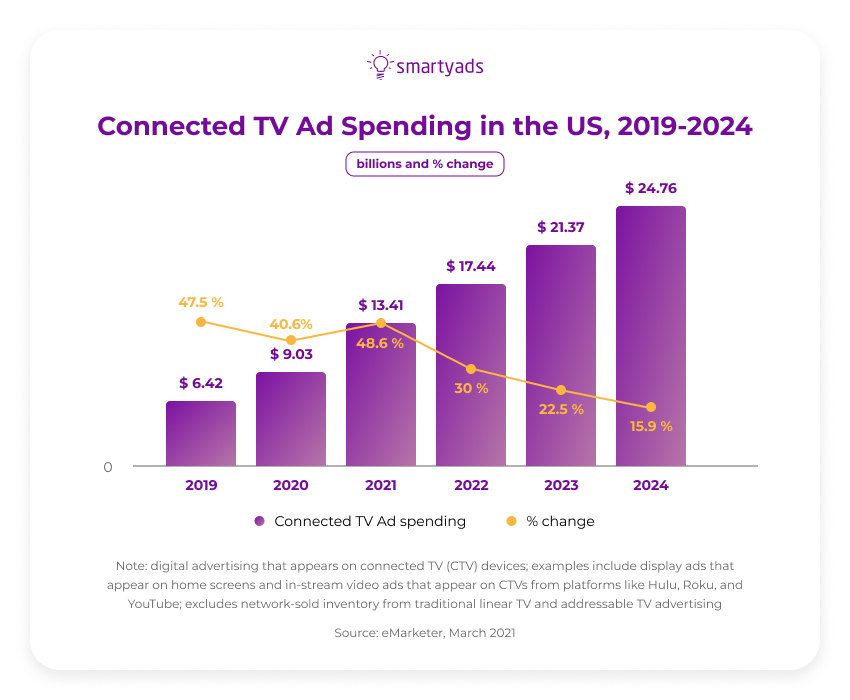
Additionally, brands today use automation (self-service and managed service platforms) to buy or sell ads on TV, which eliminates ad spend, provides great measurement capabilities, and gives a chance to reach audiences across the globe.
To sum it up
Advertising on streaming services has become an integral part of the advertising strategy of a wide variety of brands. And thanks to programmatic advertising platforms, it's also accessible to businesses of all kinds and sizes.
These ads have excellent targeting capabilities, and it's also one of the best ways to reach your target audience. If you're not using streaming ads, now is the time to start doing so.
Run your first ads on streaming platforms with programmatic advertising on SmartyAds DSP!

